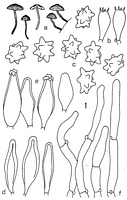|
 Inocybe paracerasphora Inocybe paracerasphora
SynonymsAstrosporina paracerasphora
BiostatusPresent in region - Indigenous. Endemic
Images (click to enlarge)
Caption: Fig. 1. Astrosporina paracerasphora
(type): a, carpoiphores; b, basidia; c, spores;d, cheilocystidia; e, pleuro^
cystidia, f, caulocystidia. | 
Caption: Dried type specimen
Owner: Herb PDD |
Article: Horak, E. (1978) [1977]. Fungi Agaricini Novaezelandiae. VI. Inocybe (Fr.) Fr. and Astrosporina Schroeter. New Zealand Journal of Botany 15(4): 713–747 (http://www.rsnz.org/publish/abstracts.php).
Description: Pileus -20 mm diam., hemispherical becoming,
convex to broadly umbonate-expanded; bark brown to umber-brown, covered with
minute concolorous scales and squamules, especially around disc; dry with brown
fibrillose veil remnants at margin in young carpophores. Lamellae adnate or
adnexed ventricose, crowded (L -16, 1 -3); beige turning beige-brown or beige-grey,
edge albofimbriate. Stipe -20 x -2mm, cylindrical, brown to black-brown often
paler than pileus; pruinose above, towards the base covered with woolly fibrils;
dry, hollow, cortina indistinct. Context brown. Odour none.
Spores 10-11.5 x 7-9 µm, distinctly nodulose,
brown. Basidia 20-25 X 10 µm. 4-spored. Cheilocystidia and pleurocystidia 30-50
x 10-18 µm, lageniform, thick-walled, hyaline, sometimes encrusted. Caulocystidia
clusters of cylindrical hyphae, thin-walled membranes. Cuticle a trichoderm
of bundled cylindrical hyphae (6-12 µm diam.), membranes up to 2 µm in diam.,
encrusted with dark brown pigment. Clamp connections numerous.
Habitat: On rotten wood of Nothofagus fusca.
New Zealand.
Notes: As the name indicates this species is closely
related to A. cerasphora Singer (1953) which grows on rotten logs of
Nothofagus spp. in the beech forests of Chile and Argentina.
|